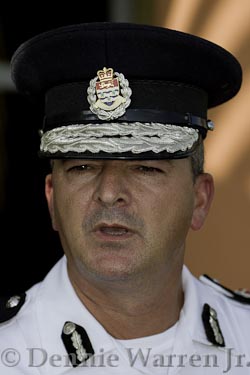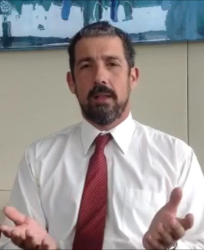Archive for March, 2014

Work force agency goes on road to help job seekers
 (CNS): Local unemployed workers looking for a job will be able to go to their district library over the next two weeks to get direct help from government officials and check the database of vacancies registered with the National Workforce Development Agency (NWDA), officials said. How many jobs are open is unclear but the NWDA said it is going out to the community in an effort to, what it described as “provide improved customer service to its clients in their job seeking efforts.” The agency will have a representative at the district libraries on Mondays and Wednesdays.
(CNS): Local unemployed workers looking for a job will be able to go to their district library over the next two weeks to get direct help from government officials and check the database of vacancies registered with the National Workforce Development Agency (NWDA), officials said. How many jobs are open is unclear but the NWDA said it is going out to the community in an effort to, what it described as “provide improved customer service to its clients in their job seeking efforts.” The agency will have a representative at the district libraries on Mondays and Wednesdays.
The government agency said this would provide opportunities for job seekers to register online with the NWDA and to search the online job portal and self-refer for vacancies – in other words make an application. They will also provide assistance with preparing resumes and help with getting ready and getting through an interview successfully.
The officials will be at the East End Library on Monday, 31 March 10:00am -1:00pm and then at the Bodden Town Library on Wednesday, 2 April 2:00pm -5:00pm. The following week they will be at North Side Library on Monday, April 7 10:00am -1:00pm and then West Bay on Wednesday, April 9 10:00am -1:00pm.

$500K debt paid to pensions
 (CNS): The government department responsible for private sector pensions is finally getting to grips with the major delinquency issues surrounding private sector pensions and the massive failure on the part of local employers to follow the law and the even bigger past failure of the authorities to enforce it. According to the director of Labour and Pensions, who has been focusing heavily on this growing and potentially disastrous problem for Cayman, since the start of the year, employers have paid in almost a half million of owed cash including cash directed into funds by the courts. The number of delinquent cases has also been reduced from near 700 in 2011 to 159.
(CNS): The government department responsible for private sector pensions is finally getting to grips with the major delinquency issues surrounding private sector pensions and the massive failure on the part of local employers to follow the law and the even bigger past failure of the authorities to enforce it. According to the director of Labour and Pensions, who has been focusing heavily on this growing and potentially disastrous problem for Cayman, since the start of the year, employers have paid in almost a half million of owed cash including cash directed into funds by the courts. The number of delinquent cases has also been reduced from near 700 in 2011 to 159.
Based on data provided by two of the six multi-employer pensions plans, officials from the national pensions office said that since January 2014 delinquency payments received from employers in arrears beyond those resolved in court have accumulated to the value of CI$468,416.
The National Pensions Board (NPB) also revealed In a progress report released Thursday March 27 (CNS has requested a copy and is awaiting a response) that the long-standing backlog of complaints files and related cases has been cut dramatically. Originally the office was facing a mountain of almost 700 case files but an audit of those complaints through 2012 and 2013 led to a revised count of 378 files. The audit revealed a number of redundant as well as multiple duplicated files on the same business. As of 28 January 2014 another 219 files were resolved or closed.
Of the remaining 159 cases currently open, the officials stated that 84 are under investigation, 52 are identified to be fast tracked, six are on a payment plan, 11 have been resolved but not closed and only six have been found to be statute-barred.
During the twenty month review period the NPO had assigned four permanent Senior Pensions Officers and four temporary officers to tackle the remaining files and the work appears to have paid off.
Officials said the officers prioritised several aging files going back to1998 when the law to mandate pensions was passed. But officers have also been working on the most recent complaints and officials said interim data suggests that since the start of the year 86 new complaints were resolved with an accumulated value of CI$131,326.
Two long-standing cases involving charges for breaches of the law were resolved in Court with payments of arrears by the two employers into the pensions fund account of the employees of those companies, made in the amount of CI$148,000.00.
Director of the Department of Labour Pensions, Mario Ebanks was pleased with the progress.
“The SPO’s [Senior Pensions Officer] defined a robust strategy to review and process the outstanding files, which proved to expedite our work,” he said. “Although it will be some time until we get caught up with all of the backlog cases, including progressing some for prosecution, we now have a more accurate position of where we are with respect to the backlog cases.”
He said the department would continue to work diligently to monitor and manage the ongoing pensions' delinquencies and arrears, resolve new complaints, as well as educate employers and employees on the National Pensions Law and the regulations.
The National Pensions Office, a division of the Department of Labour and Pensions, is located on the 2nd Floor, Mid Town Plaza, Elgin Avenue, George Town, and can be contacted at 945-8960 during regular business hours of Monday to Friday, 9:00 am – 4:00 pm. The office's website is at www.npo.gov.ky. The Department has also established a hotline for confidential information and tips, tel. 345-945-3073.

CoP report to go to DPP
 (CNS): The director of public prosecutions will be the person who makes the final decision on the police commissioner’s use of force during an arrest on New Year’s Day. Although it is still unclear which officer within the ranks of the RCIPS conducted the internal investigation into their boss, the governor’s office confirmed this week that the report is near completion. Once finalised the report will go to Cheryl Richards, QC, who will decide if David Baines was right to use his vehicle to run over a suspected robber fleeing on foot or if he went too far and should be charged. Officials from Governor Helen Kilpatrick’s office also confirmed they now have the report surrounding the circumstance leading up to the death of PC Raphael Williams.
(CNS): The director of public prosecutions will be the person who makes the final decision on the police commissioner’s use of force during an arrest on New Year’s Day. Although it is still unclear which officer within the ranks of the RCIPS conducted the internal investigation into their boss, the governor’s office confirmed this week that the report is near completion. Once finalised the report will go to Cheryl Richards, QC, who will decide if David Baines was right to use his vehicle to run over a suspected robber fleeing on foot or if he went too far and should be charged. Officials from Governor Helen Kilpatrick’s office also confirmed they now have the report surrounding the circumstance leading up to the death of PC Raphael Williams.
Williams (45) took his own life two days after he was released on police bail, having been arrested on allegations of blackmail and breach of trust and suspended from duty. His body was found hanging from a tree in the East End bush and officers from the Bermuda Police Service were invited here to investigate the circumstances leading up to his death and his questioning by the Anti-corruption Unit. Although few details were released regarding the allegations made against Williams, it is understood that he was not trying to extort cash.
The governor’s office stated that while the governor is reviewing that report, it will not be made public for some time as the officer’s suicide will be the subject of a coroner’s hearing and no date has yet been set for what will be a public enquiry.
The report on the commissioner’s apprehension of the three jewel robber suspects on New Year’s Day has taken several weeks and its author remains a mystery.
Despite documentation seen by CNS that indicated that Deputy Commissioner Anthony Ennis was undertaking the investigation, the senior officer denied having anything at all to do with the internal enquiry. It is understood that his involvement went no further than him being the gold command officer at the time Baines ran over a suspect during the high profile arrest of three men he saw fleeing from Diamonds International on New Year’s Day in downtown George Town.
Although Detective Inspector Joseph Wright is in charge of the robbery investigation, CNS understands that he did not conduct the probe into the commissioner’s use of force.
The arrest by the commissioner won him wide commendations from the public, which in the face of rising crime was buoyed by seeing a senior police officer getting his hands dirty on the frontline of the crime fight. In a major coincidence, the incident occurred on the day after the revelation that Baines had received an OBE in the Queen's honours list for his services to policing in the Cayman Islands, despite being here for less than five years and leading the RCIPS at a time when crime was considered to have reached unprecedented levels.
However, one of the men was struck down by the commissioners car and run over. Jonathan Ramoon was pinned under the vehicle and sustained a number of arm and leg injuries. It took some two hours for the police to free him and he remained in a wheel chair during his most recent court appearance.
So far, none of the suspected three robbers have formally answered the charges but they are all facing a minimum of ten years jail time if convicted.

Defence claims Ming was police informant
 (CNS): The possibility that others may have wanted Damion Ming dead was raised in court Thursday, as the lawyer representing Raziel Jeffers, who is charged with his murder, probed the lead officer about Ming’s role as an informant. The question of whether or not Ming gave any evidence to police about two robberies, the suggestion that he could have had something to do with the killing of Alrick Peddie and his criminal and gang involvement were raised by the defence with police witnesses involved in the investigation. However, Malcolm Kay, the Senior Investigating Officer (SIO) on the case, was stationed on Cayman Brac before heading up the murder enquiry and knew little about Ming’s circumstances before he was killed.
(CNS): The possibility that others may have wanted Damion Ming dead was raised in court Thursday, as the lawyer representing Raziel Jeffers, who is charged with his murder, probed the lead officer about Ming’s role as an informant. The question of whether or not Ming gave any evidence to police about two robberies, the suggestion that he could have had something to do with the killing of Alrick Peddie and his criminal and gang involvement were raised by the defence with police witnesses involved in the investigation. However, Malcolm Kay, the Senior Investigating Officer (SIO) on the case, was stationed on Cayman Brac before heading up the murder enquiry and knew little about Ming’s circumstances before he was killed.
Taking the witness stand, Kay said he could not answer questions about Ming’s role as an informant as he had no dealings with him and was not on Grand Cayman for several years before he was brought back to head up the investigation. Michael Wolkind, QC, had questioned Kay about Ming’s background and queried whether or not he had given information to the police about other well-known West Bay gang members being involved in the Cayman National Bank robbery in West Bay and another at Fosters. Kay said he did not know anything about that.
The SIO acknowledged that Ming was well known to the police and accepted that he had a long rap sheet, which included drug trafficking, firearms and accessory to robbery. But the senior officer, who is now with CID in George Town, said at the time he knew little about the victim’s previous history because he had been in the Brac as head of the station there. He returned for just two months to head up the investigation, he explained, as the RCIPS was stretched to the limit at the time. As well as the Ming case, the police were dealing with a number of other killings, which were all believed to be gang related, and Kay said it was “all hands to the pump”.
He was also unable to give Wolkind much information about comments made to officers in the immediate wake of the murder from neighbours near the scene of the crime that may have seen men dressed in black getting into a white car and speeding away. Kay said that house-to-house enquiries were conducted around the area and had anybody seen something like that he believed that the police would have followed up those leads.
One of the 14 officers who had also come to support the RCIPS from the UK took the stand via video link Thursday and spoke about her interviews with the crown’s key witness and the defendant’s former girlfriend.
She stated that the crown’s leading witness had told her on 7 May about the confession Jeffers had allegedly made about Ming’s killing and she told the officer it was the Friday morning, the day after the murder. The UK officer, one of 14 brought over to assist with the various murder enquiries, said she had not made any notes or recorded anywhere that the witness ever said the confession was made to her on the Saturday.
However, during her own evidence to the court this week, Jeffers’ former girlfriend had said she was wrong about the Friday and believed it was the Saturday that Jeffers had made his unexpected confession about killing her friend Ming.
The UK police officer also confirmed that police were aware that Ming had reportedly sent a text message to Peddie, who was known as ‘Bling’, the day before his killing on 24 March, saying that there was only room for one ‘Bling’ on the island. This was the day before Ming was murdered on 25 March.
As the crown has now called what it expected to be its final live witness, the court is now expected to hear the admission statements Friday morning before the case against Jeffers is closed and the defence begins its response.
The case continues in Grand Court before a jury and Justice Malcolm Swift.

Wheelchairs go walkabout
 (CNS): The Cayman Islands Hospital appears to be suffering from a non-medical epidemic, with 30 wheelchairs having disappeared from the premises over the last five years. Health Services Authority CEO Lizzette Yearwood acknowledged the problem and estimated that each year, anywhere from five to eight wheelchairs go missing. On a daily basis, there should usually be about 10 wheelchairs available for use throughout the hospital, but these days that number is down to eight, she said. The most likely reason for the disappearing wheelchairs, which cost between $200 and $300 each, is that people are simply taking them, with no intention of bringing them back, Yearwood explained. (Photo bySandra Catron)
(CNS): The Cayman Islands Hospital appears to be suffering from a non-medical epidemic, with 30 wheelchairs having disappeared from the premises over the last five years. Health Services Authority CEO Lizzette Yearwood acknowledged the problem and estimated that each year, anywhere from five to eight wheelchairs go missing. On a daily basis, there should usually be about 10 wheelchairs available for use throughout the hospital, but these days that number is down to eight, she said. The most likely reason for the disappearing wheelchairs, which cost between $200 and $300 each, is that people are simply taking them, with no intention of bringing them back, Yearwood explained. (Photo bySandra Catron)
“It is suspected that patients are taking them off the hospital compound and not returning them,” she said. At the moment, there are no security measures in place to prevent the chairs being taken, but the administration is now being forced to take precautions.
Larger hospitals, such as those in the US, employ security staff who routinely guard against wheelchairs being taking off premises, but that requires additional personnel.
“We are in the process of securing the wheelchairs, which includes locking them until they are required by a patient,” Yearwood said. “We have also started to place poles on the chairs to prevent them from being placed in vehicles.”
Patients with trucks can still fit the chairs in their vehicles, however, a point made by Cyndy Ebanks, a nurse in the hospital’s Ambulatory Care Unit. She has been dealing with trying to keep the unit’s lone wheelchair safe for years. In 2006, they received a dedicated wheelchair but it has been an ongoing problem holding onto it.
“Once the chair disappeared for about six months,” Ebanks recalled. “One of the hospital’s security staff saw it in someone’s shed in the Eastern Districts and recognised it. He brought it back to the hospital and after that a staff member donated a bicycle chain. We now keep it locked in a room in the unit.”
Suggesting that porters, who are responsible for in-hospital transport, should always remain with the wheelchairs, Ebanks added, “I’d rather push the patient to the entrance myself so I can bring the chair right back to the unit.”
Another staff member gave examples of wheelchairs being found on the roads after whoever was using them simply left them in the street when they were no longer needed.
Estimates from other hospital personnel put the number of wheelchairs now available as low as five, including the ACU chair, with two dedicated to maternity, one donated to the Critical Care Unit and one “roaming’ chair for the other units and wards.
The Accident and Emergency and dialysis units are the most frequent users, along with elderly or immobile inpatients who need to be transported within the hospital, or outpatients who have to be wheeled to and from their cars. For whatever the use, the issue of wheelchairs being removed creates a continuing hardship. “I am appealing to any one who uses the wheelchairs to ensure they are returned safely so they can be available for the next patient who is in need,” Yearwood said.
Ebanks added her own appeal: “Please bring them back because it could be your mother or father who needs a wheelchair and there aren’t many available. If you have any in your home, bring them to the hospital, no questions asked.”
Yearwood said she would welcome any donations of wheelchairs, and thanked previous sponsors who have helped provide chairs over the years.

Violence earns 1st offender five years jail
(CNS): A 24-year-old local man with a previously squeaky clean record was handed a jail sentence of five years and two months Thursday after he was convicted for what was described as an “unprovoked and extremely violent” attack. Nicholar Orlando Kerr was convicted of wounding with intent to cause grievous bodily harm following an early morning assault outside the victim’s home in the swamp area of George Town last summer. During the sentencing the court heard that there had been bad blood between Kerr and the victim, known as ‘Ice’, which came to a head when Kerr ran his victim down, crashed into his apartment, engaged in a fist fight and then stabbed him in the chest and neck.
The complainant suffered a punctured lung as well as a serious neck wound and various other lacerations during the attack, which started, the court heard, when Kerr had unexpectedly spotted his victim arriving home after the men had both attended the same late night party in the industrial area of the capital.
As the complainant arrived home, and was trying to find his keys to open the door, he heard a car revving close by and turned to see Kerr driving the vehicle directly towards him. In an effort to escape the victim dived into a passage but was still struck in the legs by the car, which also smashed into the apartment wall. In a bid to escape his attacker, 'Ice' jumped over the front of the car and began to run but he was caught by his attacker, who had left his crashed car and gone after his victim on foot.
The men reportedly engaged in a fist fight, during which ‘Ice’ was said to have bitten his attacker in the chest, but at some point during the fight Kerr stabbed his opponent multiple times. However, the question of how Kerr got the knife remained unanswered. Kerr claimed it came from his victim while ‘Ice’ said it came from one of Kerr’s friends that had been in the car with him when he arrived at his home.
Following the fight ‘Ice’ was taken to hospital by a person described as a good Samaritan and treated for serious injuries in the intensive care unit.
Meanwhile, Kerr headed to the police station, where he turned himself in, claiming that he had been attacked first and the entire episode was a matter of self-defence. Given the seriousness of his victim’s injuries, he was, however, ultimately charged with attempted murder and an alternative count of wounding with intent to cause GBH.
At first Kerr had denied the charges, pleading not guilty to both counts. But on the morning of the trial Kerr’s attorney made an application, and following legal arguments he agreed to plead guilty to wounding with intent.
The judge heard that Kerr had no criminal record at all, that he was gainfully employed, college educated, from a stable family background and in a stable relationship with his fiancé. He was the father of a young child, with whom he was very actively engaged and paid maintenance for. He submitted glowing references from his employers and pastor to the court and following a social enquiry report Kerr was rated as having a very low risk of re-offending.
The out of character violent attack was described as an inexplicable aberration that may have been connected or motivated by an attack that he said had been perpetrated against him at an earlier date by the victim. Although Kerr reported that attack, no action was taken following police enquiries.
As he imposed a sentence of five and half years on Kerr, in which he had included a six month discount for his very late guilty plea, Justice Malcolm Swift said that the only apparent motive for the violent attack was vengeance. The judge noted that Kerr had been very determined to harm his victim, illustrated by the fact that he smashed up his own car in his efforts to run the man down.
The judge ordered that four months of Kerr’s sentence had already been served because although he had been bailed, he was on an electronic tag and a home curfew of varying hours since his arrest. The judge calculated that the lock-down curfew period of each day equated to a half or a quarter of a day in jail, as he credited him with the time served and sent him down to begin serving the remaining five years and two months.
WEPS tops child/teacher ratio
(CNS): The West End Primary School (WEPS) on Cayman Brac has a better student/teacher ratio than the Lighthouse School, which is dedicated to special education needs (SEN) students. WEPS has six children for every teacher, compared to a student/teacher ratio of about 7:1 at Lighthouse. At the Brac's Creek & Spot Bay (C&SB) primary the ratio is about 8:1, compared to 9½:1 at North Side, the school with the most teachers per child of all primaries on Grand Cayman other than Lighthouse, according to figures released by the education ministry following a freedom of information request by CNS. However, the ministry's chief officer has said that the data for Cayman’s primary schools indicates no strong connection between the size of the class and students outcomes.
"In fact, some of our largest classes, in some cases including our maximum class size of 28, have the highest rates of progress and achievement in mathematics and English according to the data, whereas other smaller classes, including some of only 5 students, have the lowest progress rates," CO Mary Rodrigues told CNS.
The figures provided (see below) do not include the Little Cayman Education Service, which has three primary students taught by one teacher and one teacher's aide. The numbers include classroom teachers as well as staff for specific areas, such as physical education, music, art and SEN, some of whom teach at more than one school, which accounts for the fractions of teachers in the numbers supplied.
Peripatetic staff on Cayman Brac teach at two schools over three campuses. Since the Creek and Spot Bay schools successfully amalgamated in 2003, the Reception class through Year 3 have been taught at the Creek, while kids in Years 3 to 6 attend the Spot Bay campus.
The total number of primary students on Cayman Brac is 137, from Reception through Year 6. There are seven classes at C&SB, the smallest being Year 1 with five students and the largest being Year 3 with 16. At WEPS there are only two year-group classes in double figures: Reception with 12 children and Year 4 with ten. Of the rest, there is one class of five students, two of six and the others have seven and nine children.
The schools with the highest student/teacher ratio are Prospect Primary (about 19:1) and Savannah (about 18:1). John A. Cumber Primary has the most students, with a current enrollment of 587 and about 16 children per teacher. Red Bay has a ratio of about 15:1, while Bodden Town and George Town primaries each have slightly more than 13 children per full time teaching staff.
The smallest school on Grand Cayman is North Side with 88 students, and the school has a better student/teacher ratio than the next smallest, East End, which has 108 students and slightly more than 12 students per teacher.
Commenting on the figures, Chief Officer Rodrigues pointed out that most researchers support the position that class size is only one factor impacting student outcomes and that teacher effectiveness is a more significant factor in promoting student success.
While there is no clear consensus among international researchers on the impact of reducing class sizes, Rodrigues said, in terms of budget decisions there is consensus that when it comes to raising student attainment, class size reduction policies are not the best option to get value for money compared to others, such as increasing teacher effectiveness.
“Much of the discussion depends upon what the starting point for class size reduction actually is,” she added, noting that in some successful countries, such as Japan, class sizes can be over 40, though most countries maintain primary classes in the low 20's wherever possible.
With regards to very small classes, the chief officer pointed out that some research indicates that reducing class sizes below 10-15 children has no increased benefit and may even have negative impacts.

Beneficial ownership registry costly with little benefit
 (CNS Business): Making beneficial ownership information available to the wider public carries significant risks that people living in places that are safe, like Cayman or the UK, forget or do not understand, according to Cayman Finance CEO Gonzalo Jalles. “There are parts of the world where unfortunately, the wealthy are under risk and therefore there has to be right of privacy,” he told CNS Business in this week’s video interview. Representing the umbrella organisation for Cayman’s financial services industry, he said they believe a central registry would add cost to customers for little to no benefit. Read more in CNS Business
(CNS Business): Making beneficial ownership information available to the wider public carries significant risks that people living in places that are safe, like Cayman or the UK, forget or do not understand, according to Cayman Finance CEO Gonzalo Jalles. “There are parts of the world where unfortunately, the wealthy are under risk and therefore there has to be right of privacy,” he told CNS Business in this week’s video interview. Representing the umbrella organisation for Cayman’s financial services industry, he said they believe a central registry would add cost to customers for little to no benefit. Read more in CNS Business

Parliament to meet on Cayman Brac
 (CNS): Eleven years since the Legislative Assembly was last held on Cayman Brac, LA members will be heading to the Sister Island next month to meet at the Aston Rutty Civic Centre for a three day sitting. On Tuesday 8 April the Cabinet members will also have their meeting on the Brac, more than a year since the government executive last met there, with ministers meeting at the District Administration Building in Stake Bay. Officials said government tries to hold a Cabinet session on the Brac at least once during each administration. Government has not yet revealed the costs for the LA meeting, which will see 18 members and support staff flown over and accommodated on the island for three days.
(CNS): Eleven years since the Legislative Assembly was last held on Cayman Brac, LA members will be heading to the Sister Island next month to meet at the Aston Rutty Civic Centre for a three day sitting. On Tuesday 8 April the Cabinet members will also have their meeting on the Brac, more than a year since the government executive last met there, with ministers meeting at the District Administration Building in Stake Bay. Officials said government tries to hold a Cabinet session on the Brac at least once during each administration. Government has not yet revealed the costs for the LA meeting, which will see 18 members and support staff flown over and accommodated on the island for three days.
“Holding a meeting of the LA in Cayman Brac gives us an opportunity to demonstrate our solidarity with the Sister Islands and allows the public to see how their parliament functions up close and personal,” said Cabinet Secretary Samuel Rose. “Many Cayman Brac residents have never had an opportunity to attend a meeting of the Legislative Assembly in Grand Cayman. It is all the more special given that both the Speaker and the Deputy Premier are from Cayman Brac.”
Radio Cayman and CIGTV 20 will carry the LA meeting with audio only.

Alden & Ozzie US dumps visit
 (CNS): The premier will get just a few days at home this weekend when he returns from London before he heads on out again for another overseas trip. This time it is to visit a number of waste-management and recycling centres in Florida with the minister responsible for the George Town landfill. Officials said the men will be assessing modern, efficient waste management systems in the United States as part of what the wider public considers very slow progress towards addressing the island’s most pressing problem. Despite public opinion that the dump is a major priority, the premier still emphasised the need to follow process.
(CNS): The premier will get just a few days at home this weekend when he returns from London before he heads on out again for another overseas trip. This time it is to visit a number of waste-management and recycling centres in Florida with the minister responsible for the George Town landfill. Officials said the men will be assessing modern, efficient waste management systems in the United States as part of what the wider public considers very slow progress towards addressing the island’s most pressing problem. Despite public opinion that the dump is a major priority, the premier still emphasised the need to follow process.
Premier Alden McLaughlin said government will use the processes under the Public Management and Finance Law to find a waste management solution. The processes will ensuretransparency and accountability in the tendering and procurement phases.
“While there have been previous tenders, and there are quite a few studies about this subject, the fact is that the previous iterations were not subjected to the level of research, assessment and scrutiny that the process currently requires,” he said.
As a result McLaughlin and Minister Osbourne Bodden will travel to Tampa next week to visit various relevant facilities in Florida.
One of the first stages in the procurement process is the drafting of a Strategic Outline Case document that will form the basis of an RFP for consultancy services for the delivery of an Outline Business Case. A local steering committee has been working on the SOC and hopes to have it finalised for Cabinet’s approval in the next few weeks. Once approved by Cabinet, it will be released to the public, officials said.
Bodden said he was pleased with the progress the steering committee is making on the procurement process. He also pointed to improvements that the environmental health team has made at the George Town landfill.
“I want to assure the concerned members of the public that we are not waiting on the procurement process to make improvements; we are also working hard to identify and implement interim measures to help improve the situation,” the minister said.
Steps taken to date include the removal of scrap metal through a CTC-tendered contract, the lease of essential equipment to improve operations at the landfill, enhanced fire safety measures, the procurement of much-needed equipment to replace existing non-functioning equipment that is beyond its depreciated life-span, and covering additional surface area of the landfill with soil cover.
According to the premier’s office, the men will start their waste management tour on Monday at the Lee County Solid Waste Resource Recovery Facility, which operates as Covanta Lee Inc. in Fort Meyers, Florida. The facility processes 1,836 tonnes-per-day of solid waste, while generating up to 57.3 megawatts of clean, renewable energy, of which 50 megawatts is sold to Seminole Electric Cooperative.
As a comparison, the Cayman Islands generates approximately 85,345 tonnes of waste in a year or 233 tonnes-per-day.
“This facility in Lee County serves two counties and is considered Florida’s number one facility and model. I am looking forward with great anticipation to learn a lot and see what we can look forward to here in just a couple of years. Cayman deserves no less,” said Bodden.
The facility uses secondary sewage treatment run-off from a nearby county owned treatment plant for the majority of its process water. It is also equipped with steel, tin and copper recovery systems to remove all metals from the residue.
Covanta Lee also has a recycling facility and a public drop-off centre adjacent to the facility, where residents take non-hazardous household items and yard waste for disposal.
The premier and minister are also scheduled to visit waste management facilities in Lake and Hillsborough counties. The Lake County Facility processes 528 tonnes-per-day using two 264-tonnes-per-day water wall furnaces.
Travelling with the premier and minister will be the chief officer for the ministry with responsibility for waste, Jennifer Ahearn, who is also the chair of the Integrated Solid Waste Management System Steering Committee, and the Environmental Health Director Roydell Carter.
The delegation returns to Grand Cayman on Thursday, 3 April.